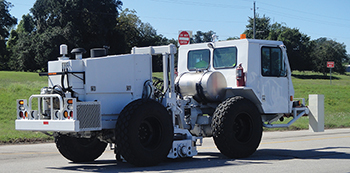Hurricane Harvey’s impact on Texas was unprecedented in many ways, including rainfall amounts, property damage and human misery. There was also unprecedented disruption and damage to Texas roadways. About a mile of SH 6 in Harris County, from Clay Road to I-10, was covered with up to 7 feet of water for 14 days. Multiple farm-to-market roads in Brazoria County were also submerged for days by 1 to 7 feet of water.

As a result, many of these roadways exhibited characteristics that Texas Department of Transportation (TxDOT) Houston District personnel had never seen before. In five locations, the pavement bulged 12 inches above the normal road surface. In other locations, continuous streams of air bubbles escaped from cracks or joints in the road. TxDOT was concerned the bubbles might have been from damaged pipelines. When the bubbles were deemed harmless, the question became, “Where are these coming from?”
What was the explanation? Were areas beneath the pavement washed out? Was the pavement structure stable? Had asphalt delaminated from the concrete base? Could the roads possibly collapse? The roads couldn’t be opened without answers.
TxDOT asked the Texas A&M Transportation Institute (TTI) Senior Research Engineer Tom Scullion and his team of forensic pavement investigators, Research Specialist Lee Gustavus and Research Associate Jason Huddleston, to survey the affected roadways and assess the damage. Using ground-penetrating radar (GPR), TTI’s total pavements acceptance device (TPAD) automated rolling deflectometer and core sampling, TTI evaluated the health of all the affected roadways. SH 6 was first. It carries tens of thousands of vehicles each day, so getting it open was critical.
“TTI has some unique, specialized equipment,” Scullion explains. “From the data we collected, we saw no indication of delaminations or washout, voided areas. We recorded deflections every 2 inches down the road. There were no anomalies in those data. After two weeks underwater, the asphalt was still bonded to the concrete, which was attributed to an excellent asphalt rubber seal coat bonding the asphalt and concrete layers together.” Following the assessment, SH 6 was reopened to traffic.

Mark Wooldridge, director of maintenance for the TxDOT Houston District, states, “TTI’s equipment and support were exceptional. The quick, timely response allowed us to verify that damage was not present on the roadways in question and enabled reopening of the roadways to traffic. The special equipment provided a much more thorough and accurate evaluation of the pavement structure than point testing, and the immediate interpretation and availability of data facilitated quick decision making.”
Scullion and his team moved on to Brazoria County near Angleton. These roads exhibited the strange air bubbles and domes — humped sections of pavement expanding upward as air is forced from beneath the pavement. “I’ve been in this business for a very long time. I had never seen anything like these domes,” says Scullion. “Neither had TxDOT personnel.”
Little is known about the original construction of these old farm-to-market roads. TxDOT wanted to be sure there were no voids under the surface that might collapse. The TPAD and GPR found no major anomalies beneath the road surface. As flood waters receded, the domes sank back to normal pavement level. Fortunately, TxDOT personnel had marked the locations of the domes.
“When we cored the areas that had risen, we found 8 to 10 inches of asphalt on the surface. Next was an old concrete layer. There had been a number of variable asphalt layers placed on top of this concrete, some exhibiting stripping with a resulting very low density,” Scullion observes.
After analyzing the data, Scullion and his team concluded the domes and bubbles were caused by the weight of the flood waters pressing down on the air trapped inside the low-density asphalt layers. Like water being squeezed from a sponge, air was being forced from the voids in the low-density asphalt layer.
“That air had to get out somewhere. If it found a joint or crack, that’s where the bubbles came from. If there was not a crack or joint nearby, the asphalt-concrete bond broke, causing the pavement to rise,” Scullion notes.
After the waters receded, there were no major safety concerns, and the roads were opened to traffic. Scullion says the condition of the roads after the flooding was a tribute to the Houston District’s pavement designs over the past 60 years.
